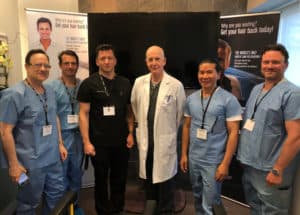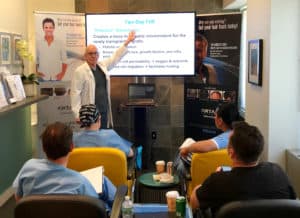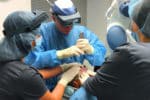May 11th, 2018 – Robert M. Bernstein MD, a pioneer in modern hair transplantation, led five robotic hair restoration physicians in an intensive master class focusing on ARTAS robotic techniques, surgical planning and aesthetics. The day included a live ARTAS Robotic FUE procedure, a series of twelve presentations and a Q & A period. The ARTAS Hair Transplant System, developed by Restoration Robotics, is the only robotic system in the world designed to aid surgeons in hair restoration procedures.
Dr. Bernstein was chosen to teach the first ever Master Class on Robotic Hair Transplantation because of his innovative work in the field of hair restoration and his contributions in the development of the ARTAS Robotic System. Dr. Bernstein is a Clinical Professor of Dermatology at the College of Physicians and Surgeons of Columbia University and founder of Bernstein Medical – Center for Hair Restoration, a state-of-the-art hair transplant facility in NYC and a beta-test center for Restoration Robotics.
Topics covered by Dr. Bernstein in the Master Class included technical aspects of robotic surgery, challenges of donor and recipient planning, hairline design, and when best to use Follicular Unit Excision (FUE). In his live demonstration and hands-on training, Dr. Bernstein also covered the techniques of Follicular Unit Graft selection and Long Hair R-FUE.
Dr. Bernstein published “Follicular Unit Transplantation” in 1995 which now serves as the groundwork for modern hair restoration. Follicular Unit Transplantation (FUT) is the technique where the donor hair is removed from the scalp in one long thin strip and dissected into individual follicular units. Dr. Bernstein pioneered Follicular Unit Excision (FUE) in 2002, with his colleague Dr. William Rassman. Follicular Unit Excision (FUE) is the process of using an instrument to make a small incision around the skin of a follicular unit to separate it from the existing tissue. In 2011, Dr. Bernstein worked with researchers from Restoration Robotics to improve the newly released ARTAS Robotic System. Bernstein Medical was one of the first facilities in the world to use the ARTAS Robot to perform FUE hair transplantation.
In the first-ever master class, Dr. Bernstein shared his deep knowledge of hair transplantation and his experience using the ARTAS Robot with fellow hair transplant surgeons who traveled across the country for this opportunity.
- Read more on ARTAS Robotic Hair Transplants
- Schedule a consult with pioneer hair transplant surgeon, Dr. Robert M. Bernstein





 Video: Tensioner Placement
Video: Tensioner Placement



